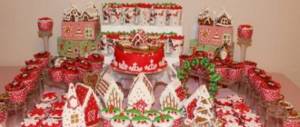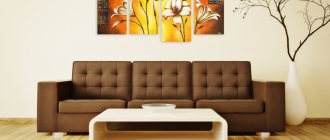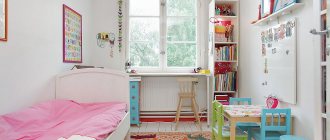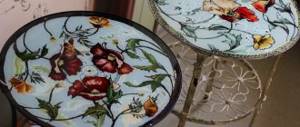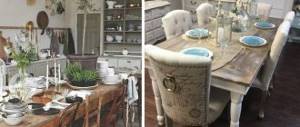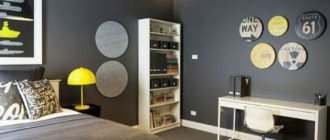The kids are growing up imperceptibly, and now parents are beginning to think about the question of how to choose a children's desk. Models for schoolchildren have special requirements: maintaining correct posture during classes, comfort, functionality, safety, reliability, long service life.
<
>
What to consider when choosing a desk for a child
The importance of choosing a desktop for a child is beyond doubt. Proper organization of the study space will ensure the preservation of health, help harmonious development, and achieve high performance.
There are a number of criteria that should be taken into account when purchasing a children's desk.
- Purpose of the product. If the model will be used only for written classes, then you can choose the simplest design. However, modern education cannot be imagined without the participation of a computer. Therefore, it is better to immediately take care of special equipment: a compartment for the system unit, shelves for office equipment, a retractable panel for the keyboard and mouse.
- Age group. The dimensions of the product and a comfortable position during exercise depend on this parameter.
- Features of the build. Larger children will need larger tables than standard models for their age.
- Lifetime. If desired, you can change the designs as the child grows older. Then it is better to prefer simple models. Those who want to equip their working hours for a long time should take a closer look at transformable products. They provide functions for changing the height and angle of the tabletop. A simple mechanism will allow you to adjust the appropriate parameters according to the child’s growth.
- Interior of a children's room. It will be possible to maintain a style decision and maintain harmony with the rest of the furnishings thanks to a specific table design.
- Execution material. You should definitely pay attention to the environmental safety (confirmed by a certificate) and the performance characteristics of the option you like.
- Functionality. It is advisable to think about a place to store textbooks, notebooks, stationery, etc. For these purposes, products equipped with a cabinet, drawers, or a superstructure of shelves are suitable.
Desk for a schoolchild: features
A school-age child spends a lot of time at a desk. Sometimes it is very difficult to involve your child in the work process, and if the table is uncomfortable, this will be extremely problematic. This does not mean that you need to turn practical furniture into a gaming accessory, but it is important to understand what properties an ideal table should have that a child would want to work at.
.
The desk should have a wide tabletop, on which the child could freely lay out all the necessary accessories, notebooks, and literature. Its height should correspond to the height of the child - he should not bend too much when writing. The standard width of tabletops is usually 70 cm - this is exactly what is enough for comfortable written work. However, modern configurations
may differ in size, since often a schoolchild’s desk with shelves and drawers is also adjacent to a place for a computer.
The student will need to place books somewhere that he will not carry to school every day, so if there is no bookcase, the table should have add-ons designed to accommodate literature. The ideal model is one that has the ability to adjust the height
legs and the degree of inclination of the tabletop.
Pay attention to the material: it must be non-toxic, ideally a quality certificate is provided for the product. This is important, since a child’s allergy to materials, glue or other furniture components does not bode well. The main parameters of a children's desk: convenience, practicality, ergonomics
.
Shapes and sizes of children's desks
Depending on the configuration, the following types of products are distinguished:
- rectangular, in order to increase safety, corners can be rounded;
- corner models in symmetrical or L-shaped design (left- and right-handed);
- wide tables with a central partition or long tables designed for two students.
To choose a product that is suitable for your child in size, you need to decide on the basic parameters.
- The distance from the floor to the lid is responsible for the correct position of the body. You can check it with regular testing. In a sitting position, the tabletop is located at the level of the solar plexus or approximately 3-5 cm above the elbow. There is at least 10-15 cm of free space between the knees and the lid. The shoulder girdle remains in its natural position if the student rests his forearms on the work surface.
- A tabletop length of 1 to 1.2 will provide enough space for the necessary accessories and elbow support.
- The minimum depth of the table is 60 cm. If it is planned to be used as a computer, the value increases to 0.8-1 m. This is necessary to maintain the correct distance between the monitor and the eyes.
<
>
How to choose a table
When choosing a table, you should pay attention to the fact that the child should sit at the desk on the right chair, while the elbows should be freely placed on the tabletop, located at the level of the solar plexus, and the back should touch the back of the chair.
When the child’s arms are lowered, the elbow should be 5-6 cm below the table top. The minimum acceptable dimensions of the tabletop must be at least 60x60 centimeters, otherwise the child will not be able to place on it all the school supplies necessary to complete the task.
Currently, there are many types of desks on the market, available to people with different incomes. Knowing the necessary requirements for a desk, as well as having an idea about the features of choosing a desk, choosing a desk is not difficult.
Types of designs for children's desks
Manufacturers offer a wide selection of products. A desk for a schoolchild can be in a classic design, combine the functions of a computer model, and have the ability to transform.
- The traditional writing utensil is easily recognized by its rectangular shape. There is a cabinet at the bottom for educational supplies. Modern models are complemented by a table shelf. The design is easy to fit into any interior.
- A corner table helps to rationally use the space of the room, occupying a usually empty corner. It combines well with other furnishings, creating a seamless ensemble with a sofa or wardrobe.
- A purely computer model is not always suitable for performing written work, as it is aimed at other functions. The way out of the situation will be a product supplemented with space for a system unit, keyboard, mouse, and with sufficient depth.
- Transformer tables offer a wide range of possibilities. They are able to “grow” with the child, so they are designed for a long service life. Change the angle of the tabletop in the range from 5° to 30°. They can also be built into various pieces of furniture: a wardrobe, a bed, a sofa, which ensures the preservation of free space in a small room.
If you wish, you can easily find the following options:
- there is a loft bed, and under it there is a table. There are usually shelves or a narrow cabinet nearby. In this case, care should be taken to ensure high-quality lighting of the workplace;
- The folding surface can completely replace a desk for a child. The product looks like a regular model in the daytime. And in the evening, the tabletop with all its contents moves up or down, freeing up space for the bed. You should install a pencil case or shelving nearby so that everything you need is at hand;
- The retractable shelf built into the cabinet is complemented by attached supports for stability. The nearest furniture compartments are reserved for educational supplies.
Criterias of choice
The choice of a desk for a schoolchild must be approached very seriously, since not only the comfort of staying at it, but also the health of the child depends on it. When going to the store to buy something, it is better to take the future owner of this necessary piece of furniture with you. Let us list the main criteria that you need to pay special attention to when choosing a desk for a student.
Dimensions
The size of the desk is an important criterion on which the comfort of work depends. The depth of the workplace should not exceed 600-800 mm, and its width should not be less than 1,000 mm. The space under the table for the child’s feet should be: 450 mm deep and 500 mm wide.
The desk must be selected in accordance with the height of the child. Standard tables are made with a height of 750 mm. If the table is selected correctly, then the legs of the sitting child will be at an angle of 90° with respect to the floor surface.
To ensure that a child’s vision does not suffer and his posture does not deteriorate when working at a table for a long time, the tabletop must be raised at a certain angle. There should be a distance of 100-150 mm between the legs of the person sitting and the lower edge of the tabletop. Doctors recommend that the tabletop angle be within the following limits:
Equipment
A modern desk is a functional piece of furniture. To realize this quality, additional equipment is used.
- Drawers.
- Stationary or roll-out cabinet.
- Open shelves.
- Footrest.
- Superstructure with shelves.
- Built-in shelving or pencil case.
- If you install a computer, you will need a retractable panel for the keyboard and mouse, a compartment for the system unit, and space for other equipment.
It is important that additional elements located in the upper part do not interfere with natural light. There should also be space on the table for lamps that allow you to work in the dark.
Types of desks for schoolchildren at home
There are several types of school tables, differing in purpose and design, these include the following types:
- desk;
- stationary;
- computer;
- transformer;
- angular;
- built-in;
- folding;
- for two children.
Built-in Desk Computer Folding Stationary For two children Transformer Corner
Desk - these school designs are equipped with a rotating tabletop. Additionally, the angle of inclination is adjustable. This allows you to perform many different actions using this item. The tabletop is adjustable in a variety of ways, allowing you to choose positions for drawing, studying, or playing board games. Additionally, the height of the desk can be changed in accordance with the height and other characteristics of the child using this item. The table can be used for many years. The desk is small and takes up less space than a standard desk. Often a transformable desk is chosen, and its basic parameters can be changed in accordance with the growth of the child.
Stationary - this product cannot be changed, since it is not equipped with any transformation elements. The standard table is comfortable for a child. It is characterized by high reliability and ease of use. It is almost impossible to break it. This home option is most often chosen for children in the 7th or 8th grade, when their rapid and spasmodic growth stops. The most commonly sold stationary design is with drawers or shelves, which allows you to store many study or game items on it. The product is presented in numerous sizes, colors and other parameters, which makes it possible to choose an option that fits perfectly into the children's room and will also be perfect for the immediate user.
Computer desk - it is considered the best option if the child’s parents have already bought a computer for study or entertainment. It is not recommended to install it on a standard table, since optimal conditions are not created when working with equipment. The computer product will provide the required distance from the monitor to the child’s eyes, which is 60 cm. The most often chosen design is in the shape of the letter G. This configuration ensures a reduction in harmful radiation from the computer. It is advisable to choose fairly large tables for schoolchildren, so that the equipment on them does not take up all the space, but a certain part. The remaining space is used for effective study.
Transformer - it is presented as a standard table, just as a transformer bed is often chosen, taking the form of a bed and a table. This design does not take up much space and can also be used when performing a large number of different important actions. In the designs, you can adjust the basic parameters of the product, for example, the height of the table changes in accordance with the growth of the child, which creates optimal conditions for study.
Corner desk - considered the ideal choice for a small children's room. It is installed in a corner not normally used for any purpose, without taking up important central free space. Typically, corner structures are equipped with drawers at the top and bottom. It is easy to arrange various writing utensils in them. All of them are freely accessible, so you only need to reach out to grab the item you need.
A built-in desk for a student is considered an excellent choice for a small room. Often it acts as a continuation of a regular window sill. Its shape and other parameters are selected in accordance with the wishes, age and height of the child who is the direct user of the product. In this case, high-quality natural light is provided during the daytime, and also does not take up much space in the room.
Folding - usually chosen for a small room where it is impossible to place a stationary structure. It is disassembled if necessary, but is usually kept assembled. It can be moved from one place to another, which makes it convenient to use such a children's one regularly. As a rule, it is chosen for a first-grader, and when the baby grows a little, he needs a more stable and reliable design.
A table for two children is chosen if 2 children live and study in the same room.
This design ensures optimal space saving. At the same time, children will not interfere with each other, and each of them will have personal space. Thus, there are many types of designs, which ensures that parents are faced with complex and specific choices.
Materials
Materials for the manufacture of children's furniture must have high performance characteristics and environmental safety. The following types are used in the production of tables.
- Tree. Products made from solid wood are endowed with a lot of advantages and fully comply with the requirements. However, wooden models are quite expensive, although the costs are fully recouped due to their long service life.
- Chipboard. This is a popular and affordable option. Its disadvantages are low strength, tendency to deform, and the risk of releasing harmful compounds.
- MDF. The price of this model is higher, but its qualities are similar to wood. The material contains no toxic substances, so it is completely safe from an environmental point of view.
- Glass. A glass table certainly looks modern and stylish, but due to its low thermal conductivity, its surface always remains cold. In addition, sharp sounds and the need for constant cleaning can cause irritation. Do not discount the natural fragility of the material and its high cost.
- Plastic. In this case, it is worth choosing a high-quality plastic product that can compete with other types. The advantages include: strength, lightness, variety of colors and shapes, environmental friendliness.
Rules for location in the interior of the room
The organization of the educational process also depends on the location of the desk in the children's room. Simple tips will help you make your choice.
- It is advisable to divide the space into zones using a screen, shelving or even wall decoration. Remove all unnecessary objects and toys, as they interfere with concentration.
- The best lighting option is sunlight. If this is not feasible, use special lamps. The luminous flux should fall from the left side, and for left-handed people - from the right. At night, at least two light sources will be required.
- It is better to place educational supplies at arm's length. It is acceptable to rise from your chair to reach the upper shelves.
- You should not place the table near the doorway, especially with your back to it, as this causes psychological discomfort. It's better to move it to a corner.
The choice of a desk for a schoolchild must be approached with all responsibility. The health and academic performance of the child largely depends on how successful the purchase is.
How to properly position a desk in a children's room
We recommend reading: Children's room for two: layout and design
Of course, everything depends on the size of the children's room, but you need to take into account a few key points :
- the table should be well lit - optimally the light should fall from the side;
- a good option is to install a desk directly next to the window, but in this case it will need to be moved 15-20 cm away from the heating radiator - this will protect the child from drafts and too dry air, and will preserve the furniture;
- if the desk is corner, then it must be placed in the corner closest to the window;
- if you are arranging a children's room for two, then the table should be located near the window, have one tabletop, but two chairs and a conditional division of the workspace.
A desk for a schoolchild is an important element in his room. Manufacturers offer quite a lot of models of this type of furniture, so you need to know what requirements apply to a particular student’s desk.
( 80 votes, average: 4.64 out of 5)
IR heater: how to choose, what types are there?
How to choose a wardrobe
